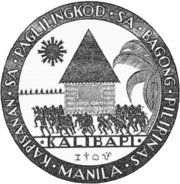
Back KALIBAPI BCL KALIBAPI Spanish KALIBAPI ID KALIBAPI Italian カリバピ Japanese 칼리바피 Korean KALIBAPI Polish KALIBAPI Tagalog
Kapisanan sa Paglilingkod sa Bagong Pilipinas | |
|---|---|
 | |
| Abbreviation | KALIBAPI |
| Leader | Directors-General: Benigno S. Aquino (1942–1943) Camilo Osías (1943–1945) |
| Secretary-General | Pio Duran |
| Founder | Philippine Executive Commission |
| Founded | December 8, 1942 |
| Dissolved | 1945 |
| Headquarters | Manila, Second Philippine Republic |
| Ideology | Filipino nationalism National conservatism Fascism[1][2][3][4] Japanophilia[5] |
| Political position | Far-right[6] |
| Election symbol | |
 | |
| Party flag | |
 | |
The Kapisanan sa Paglilingkod sa Bagong Pilipinas (Association for Service to the New Philippines),[5][7][8] or KALIBAPI, was a fascist[1][2][3][4] Filipino political party that served as the sole party of state during the Japanese occupation. It was intended to be a Filipino version of Japan's governing Imperial Rule Assistance Association.[9]
- ^ a b Peter de Mendelssohn, Japan's Political Welfare, Taylor & Francis US, 2010, p. 121
- ^ a b Cite error: The named reference
Bern163was invoked but never defined (see the help page). - ^ a b Felixberto G. Bustos, And Now Comes Roxas: The Story of the First President of the Republic of the Philippines and the Occupation, C. Z. Bustos, 1945, p. 187
- ^ a b Augusto V. de Viana, Kulaboretor!: The Issue of Political Collaboration During World War II, University of Santo Tomas Publishing House, 2003, p. 46
- ^ a b Guillermo, Artemio R. (2012), "KALIBAPI", Historical Dictionary of the Philippines (Third ed.), Scarecrow Press, p. 223
- ^ Sven Matthiessen, Japanese Pan-Asianism and the Philippines from the Late Nineteenth Century to the End of World War II: Going to the Philippines Is Like Coming Home?, p. 134
- ^ Jose (2001), KALIBAPI
- ^ Pomeroy (1992), The Philippines, p. 113
- ^ Setsuho Ikehata, Lydia N. Yu-Jose, Philippines-Japan Relations, Ateneo de Manila University Press, 2003, p. 196
© MMXXIII Rich X Search. We shall prevail. All rights reserved. Rich X Search